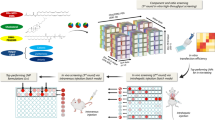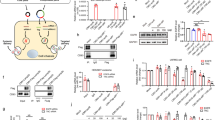Abstract
Therapeutics based on transcription factors have the potential to revolutionize medicine but have had limited clinical success as a consequence of delivery problems1,2,3,4. The delivery of transcription factors is challenging because it requires the development of a delivery vehicle that can complex transcription factors, target cells and stimulate endosomal disruption, with minimal toxicity5,6. Here, we present a multifunctional oligonucleotide, termed DARTs (DNA assembled recombinant transcription factors), which can deliver transcription factors with high efficiency in vivo. DARTs are composed of an oligonucleotide that contains a transcription-factor-binding sequence and hydrophobic membrane-disruptive chains that are masked by acid-cleavable galactose residues. DARTs have a unique molecular architecture, which allows them to bind transcription factors, trigger endocytosis in hepatocytes, and stimulate endosomal disruption. The DARTs have enhanced uptake in hepatocytes as a result of their galactose residues and can disrupt endosomes efficiently with minimal toxicity, because unmasking of their hydrophobic domains selectively occurs in the acidic environment of the endosome. We show that DARTs can deliver the transcription factor nuclear erythroid 2-related factor 2 (Nrf2) to the liver, catalyse the transcription of Nrf2 downstream genes, and rescue mice from acetaminophen-induced liver injury.
This is a preview of subscription content, access via your institution
Access options
Subscribe to this journal
Receive 12 print issues and online access
$259.00 per year
only $21.58 per issue
Buy this article
- Purchase on Springer Link
- Instant access to full article PDF
Prices may be subject to local taxes which are calculated during checkout





Similar content being viewed by others
References
Zhou, H. Y. et al. Generation of induced pluripotent stem cells using recombinant proteins. Cell Stem Cell 4, 381–384 (2009).
Takahashi, K. & Yamanaka, S. Induction of pluripotent stem cells from mouse embryonic and adult fibroblast cultures by defined factors. Cell 126, 663–676 (2006).
Huang, P. et al. Induction of functional hepatocyte-like cells from mouse fibroblasts by defined factors. Nature 475, 386–389 (2011).
Bataille, A. M. & Manautou, J. E. Nrf2: A potential target for new therapeutics in liver disease. Clin. Pharmacol. Ther. 92, 340–348 (2012).
Liu, Y. et al. Delivery of intact transcription factor by using self-assembled supramolecular nanoparticles. Angew. Chem. Int. Ed. 50, 3058–3062 (2011).
Yan, M. et al. A novel intracellular protein delivery platform based on single-protein nanocapsules. Nature Nanotech. 5, 48–53 (2010).
Barkett, M. & Gilmore, T. D. Control of apoptosis by Rel/NF-kappaB transcription factors. Oncogene 18, 6910–6924 (1999).
Giudice, A., Arra, C. & Turco, M. C. Review of molecular mechanisms involved in the activation of the Nrf2-ARE signaling pathway by chemopreventive agents. Methods Mol. Biol. 647, 37–74 (2010).
Mitsuishi, Y. et al. Nrf2 redirects glucose and glutamine into anabolic pathways in metabolic reprogramming. Cancer Cell 22, 66–79 (2012).
Cuadrado, A., Moreno-Murciano, P. & Pedraza-Chaverri, J. The transcription factor Nrf2 as a new therapeutic target in Parkinson’s disease. Expert Opin. Ther. Targets 13, 319–329 (2009).
Crawford, R. et al. Non-covalent single transcription factor encapsulation inside a DNA cage. Angew. Chem. Int. Ed. 52, 2284–2288 (2013).
Biswas, A., Liu, Y., Liu, T., Fan, G. & Tang, Y. Polyethylene glycol-based protein nanocapsules for functional delivery of a differentiation transcription factor. Biomaterials 33, 5459–5467 (2012).
Murthy, N., Campbell, J., Fausto, N., Hoffman, A. S. & Stayton, P. S. Bioinspired pH-responsive polymers for the intracellular delivery of biomolecular drugs. Bioconjugate Chem. 14, 412–419 (2003).
Liu, Y. et al. Delivery of intact transcription factor by using self-assembled supramolecular nanoparticles. Angew. Chem. Int. Ed. 50, 3058–3062 (2011).
Lee, K., Lee, H., Lee, K. W. & Park, T. G. Optical imaging of intracellular reactive oxygen species for the assessment of the cytotoxicity of nanoparticles. Biomaterials 32, 2556–2565 (2011).
Dube, D., Khatri, K., Goyal, A. K., Mishra, N. & Vyas, S. P. Preparation and evaluation of galactosylated vesicular carrier for hepatic targeting of silibinin. Drug Dev. Ind. Pharm. 36, 547–555 (2010).
Cheng, C., Convertine, A. J., Stayton, P. S. & Bryers, J. D. Multifunctional triblock copolymers for intracellular messenger RNA delivery. Biomaterials 33, 6868–6876 (2012).
Hybertson, B. M., Gao, B., Bose, S. K. & McCord, J. M. Oxidative stress in health and disease: The therapeutic potential of Nrf2 activation. Mol. Asp. Med. 32, 234–246 (2011).
Tanaka, Y. et al. NF-E2-related factor 2 inhibits lipid accumulation and oxidative stress in mice fed a high-fat diet. J. Pharmacol. Exp. Ther. 325, 655–664 (2008).
Sekhar, K. R. et al. NADPH oxidase activity is essential for Keap1/Nrf2-mediated induction of GCLC in response to 2-indol-3-yl-methylenequinuclidin-3-ols. Cancer Res. 63, 5636–5645 (2003).
Farombi, E. O. & Surh, Y. J. Heme oxygenase-1 as a potential therapeutic target for hepatoprotection. J. Biochem. Mol. Biol. 39, 479–491 (2006).
Suh, J. H. et al. Decline in transcriptional activity of Nrf2 causes age-related loss of glutathione synthesis, which is reversible with lipoic acid. Proc. Natl Acad. Sci. USA 101, 3381–3386 (2004).
Larson, A. M. et al. Acetaminophen-induced acute liver failure: Results of a United States multicenter, prospective study. Hepatology 42, 1364–1372 (2005).
Chan, K., Han, X. D. & Kan, Y. W. An important function of Nrf2 in combating oxidative stress: Detoxification of acetaminophen. Proc. Natl Acad. Sci. USA 98, 4611–4616 (2001).
Acknowledgements
This work was supported by grants from the NIH, U01 268201000043C-0-0-1, RO1 AI107116-01 and RO1 AI088023-03. In addition, this work was supported by the WM Keck Foundation, based in Los Angeles, USA. We thank S. Maity and M. Webb for chemistry advice, and M. West in the Berkeley Stem Cell Center for technical assistance.
Author information
Authors and Affiliations
Contributions
K.L., M.R., X.W., X.F. and N.M. designed the experiments. X.W. and X.F. carried out organic synthesis. K.L., M.R., X.F., C.S, R.T. and N.L. performed characterization, in vitro, and in vivo experiments. All of the authors were involved in the analyses and interpretation of data. K.L., M.R., X.W. and N.M. wrote the paper, with the help of the co-authors.
Corresponding author
Ethics declarations
Competing interests
The authors declare no competing financial interests.
Supplementary information
Supplementary Information
Supplementary Information (PDF 5482 kb)
Rights and permissions
About this article
Cite this article
Lee, K., Rafi, M., Wang, X. et al. In vivo delivery of transcription factors with multifunctional oligonucleotides. Nature Mater 14, 701–706 (2015). https://doi.org/10.1038/nmat4269
Received:
Accepted:
Published:
Issue Date:
DOI: https://doi.org/10.1038/nmat4269
This article is cited by
-
Engineered biomaterials for in situ tissue regeneration
Nature Reviews Materials (2020)
-
Synthetic materials at the forefront of gene delivery
Nature Reviews Chemistry (2018)
-
The fluorination effect of fluoroamphiphiles in cytosolic protein delivery
Nature Communications (2018)
-
Fabrication of genetically engineered polypeptide@quantum dots hybrid nanogels for targeted imaging
Journal of Nanoparticle Research (2017)



